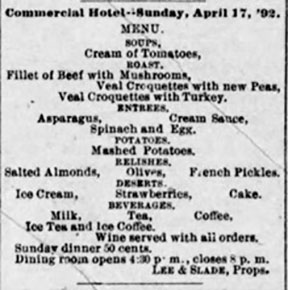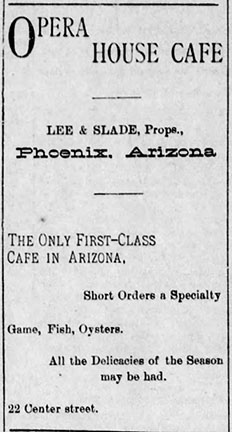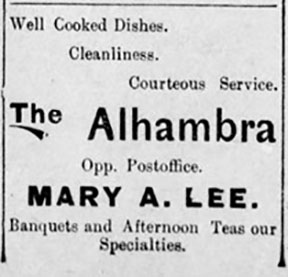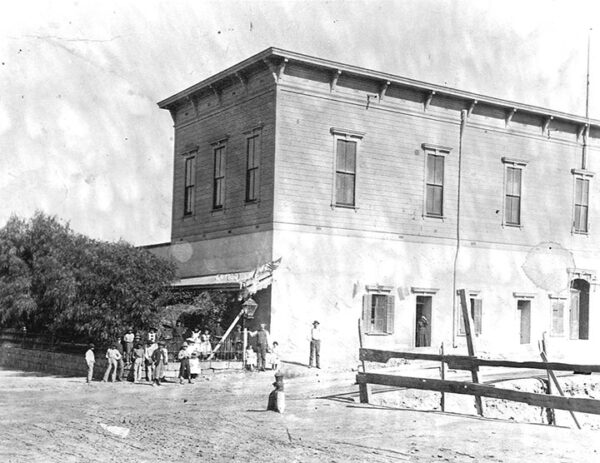
Mary A. Lee, a Successful Black Businesswoman in Territorial Arizona
Homer Thiel tells the story of a prominent Black businesswoman who built successful culinary ventures in both Phoenix and Tucson in the late 1800s.
Hundreds of African Americans arrived in the Territory of Arizona between 1856 and 1912. Early on these included escaped enslaved men such as Hampton Brown. After the Civil War ended, free Black men and women came west in search of economic opportunities.
One of these people was Mary A. Lee, born circa 1862. Nothing is known about her early life at this time. She is first documented living in Denver, Colorado in 1885, working as a cook. She eventually formed a partnership with Samuel Slade and they operated the kitchen and dining room at the Luray Hotel in Denver.
In March 1892, the pair leased the Commercial Hotel in Phoenix. A menu printed in the Arizona Republican reveals the wide range of dishes that could be had in the dining room. It quickly became the most popular eating place in the community.

Commercial Hotel menu (Arizona Republican, 17 April 1892, p. 1).

A postcard of the Commercial Hotel in Phoenix.
By December 1894, the pair operated the Opera House Café. “The proprietors, Messrs. Lee & Slade, have had years of experience catering to the public. Game, fish, and all the delicacies of the season, are to be had there. When in the capital city, give them a call. They are at 22 Center street.”

Advertisement for the Opera House Cafe (Arizona Daily Star, 29 December 1894, p. 2).
In 1895 the two signed a lease to operate the Ford Hotel for $18,000 over a five-year period. They celebrated their fourth year in business in Phoenix with an elaborate supper: “Bisque Tomato Soup, Raw Oysters, Baked Baracuda, Tartar Sauce, Fillet of Beef Mushrooms, Roast Young Pig, Apple Sauce, Fried Spring Chicken Maryland Style, Lobster Salad, Picklelilli, Mashed Potatoes, New Peas, Asparagus, Lemon Meringue Pie, Apple Pie, Swiss Cheese, Tutti Frutti Ice Cream, White Mountain Cake, Salted Almons, Tea, Coffee, Milk, Wine. Lee & Slade completed their fourth years in business in Phoenix today and as usual serve an anniversary dinner.”

Advertisement for the Ford Hotel (Arizona Republican, 22 November 1895, p. 7).
The day following the 1899 supper, their partnership dissolved and Samuel Slade filed a lawsuit against Lee. He claimed Mary had threatened to kill him. In response, Mary moved to Tucson. She took over the kitchen at the New Orndorff Hotel and hired Black women to work as waitresses in the dining room.
By December 1897 she was running the Williams Boarding House and by July 1899 she ran The Alhambra restaurant.

Advertisement for The Alhambra (Arizona Daily Star, 16 July 1899, p. 4).
However, Mary was beginning to suffer from tuberculosis. She returned to Phoenix and passed away there on October 26, 1900. The Arizona Republican noted “Mary A. Lee, the best known colored woman in the territory, was buried yesterday. She was better known as a member of the old firm of Lee & Slade, restauranteurs. She has lived in the southern part of Arizona and New Mexico for the last three years and returned less than a week ago suffering from an incurable ailment and already at the point of death.” She was buried in Rosedale Cemetery in Phoenix in an unmarked grave.
Mary A. Lee was one of many African Americans who arrived in Arizona during the Territorial period. She was a successful cook, one of the best-known in the area, during her tenure. She also operated hotels and employed other Black people in a time when discrimination limited the opportunities of non-White individuals. Today she is remembered for her drive and ambition, as well as her elaborate menus.



